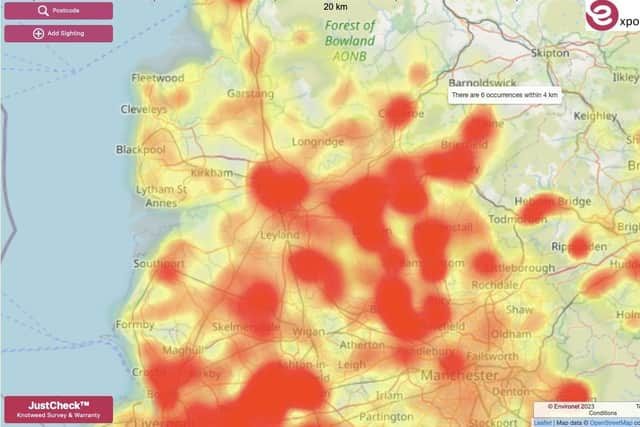Japanese knotweed: Lancashire hotspots revealed - and what to do if you think you have the invasive plant
and live on Freeview channel 276
As Japanese knotweed’s summer growth period draws to a close, invasive plant specialist Environet has analysed the latest data from its live online tracker to reveal this year’s Japanese knotweed hotspots.
Populated with almost 58,000 known infestations of the UK’s most invasive plant and charting its spread across the country, Exposed: The Japanese Knotweed Heatmap alerts homeowners and homebuyers to the risk level in their local area. Users can enter their postcode directly into the map to discover the number of verified knotweed sightings within a 4km radius, with hotspots highlighted in yellow, orange or, in the worst cases, red. They can also add sightings by uploading a photo to be verified by experts.
Advertisement
Hide AdAdvertisement
Hide AdThe Lancashire Japanese knotweed hotspots for 2023 are as follows:


Preston - 857.
Blackburn - 541.
Chorley - 365.
Burnley - 310.


Accrington - 236.
Rossendale - 220.
Clitheroe - 212.
Carnforth - 133.
Ormskirk - 115.
Lancaster - 91.
With a total of 3,530 known infestations across Lancashire, there are 1.1 occurrences of Japanese knotweed in every 1 km². Preston is also fifth on the list of national hotspots, after Swansea, Bolton, Bristol and Cardiff.
Japanese knotweed usually emerges in March or April and grows rapidly to reach up to 2.5 metres in height by mid-summer.
It is identifiable by its hard, bamboo-like canes and distinctive shield-shaped bright green leaves which grow in a zigzag pattern along the stem.
Advertisement
Hide AdAdvertisement
Hide AdWhat to do if you think you have the invasive plant
Email a photo of the plant to Environet’s free ID service at [email protected]
Commission a professional Japanese knotweed survey to confirm the extent of the infestation, where it originated and the best way to treat it.
Put a professional treatment plant in place with an insurance-backed guarantee.
Nic Seal, founder of Environet, said: “Vigilance is the best way to protect your property from the risks posed by Japanese knotweed. Make sure you know what knotweed looks like and how it differs from other common garden weeds like ivy and bindweed, so you can keep an eye out for it in your garden and neighbourhood.
Advertisement
Hide AdAdvertisement
Hide Ad"Knotweed is easily identifiable during summer, but as we head through the autumn and into winter, the above-ground growth dies back and it becomes much harder to spot. It’s also easier to conceal, so anyone viewing a property to buy should be extra careful. There are lots of horror stories out there but the with professional help, knotweed can be successfully treated and a property’s value can be largely restored.”